Whales and Minnows: Indiana's Employment by Size
Ask the average Hoosier on the street to name three Indiana employers, and you would likely get names connected to the auto, pharmaceutical or steel industries. Certainly there are firms in these sectors that employ numerous Hoosiers at a single facility, and they are unquestionably major players in Indiana’s economy. But did you realize that the most common employment size among Indiana’s private (nongovernment) employers is one employee? Or that the median employer size (the midpoint of a distribution, where 50 percent are above and 50 percent are below) for our state is five employees? Indiana has a lot of small firms.
As part of an effort to arrive at Indiana-specific size classes for employment, the Research and Analysis division of the Indiana Department of Workforce Development spent time this summer examining Indiana’s employment by size, using the universe of private employers covered by unemployment insurance as of the third quarter 2004.
We began by averaging employment for the three months of the quarter, eliminating any firms whose employment averaged less than one. Federal, state and local government employers were excluded for this analysis. Individual worksites for companies with multiple locations (e.g. restaurants, department stores, plant locations) were included rather than the firm’s overall employment to allow the results to be mapped to the correct counties. The employer count after applying these constraints was 130,258. We discovered 23,121 establishments with an average employment of one person for the quarter. These single-employee establishments, broken down by industry codes, are shown in Table 1, with trade, financial services, and business and professional services collectively accounting for over half of these establishments. Meanwhile, other services and construction constitute the bulk of the remaining units.
Table 1: Establishments with One Employee by Industry Sector
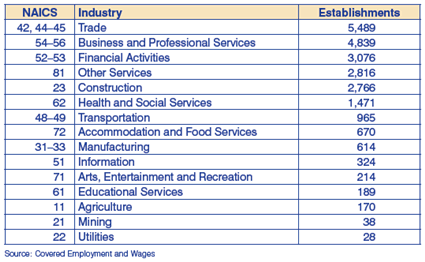
Establishments with one to nine employees are scattered throughout the state, as Figure 1 illustrates. Figure 2 depicts the distribution of these establishments.
Figure 1: Establishments with one to nine Employees
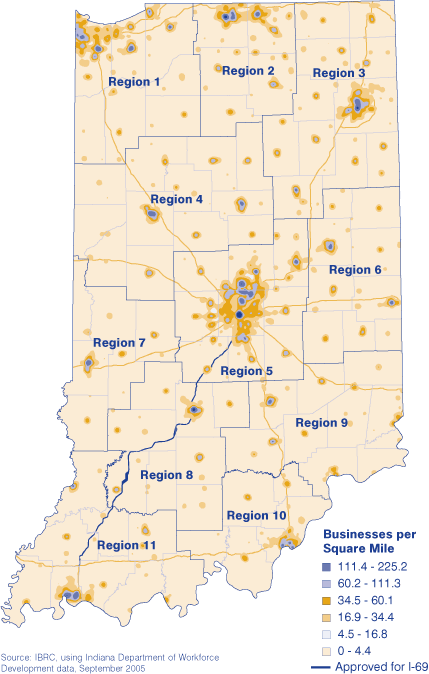
Figure 2: Employment Size, 1 to 9
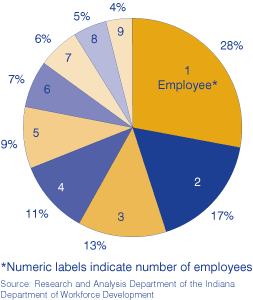
There are a total of 88,815 establishments with one to nine employees, constituting more than two-thirds of the in-scope firms. These establishments accounted for employment of 315,686 (12.8 percent of total) and wages of $2.35 billion (11.2 percent) in the third quarter.
At the other end of our employment size distribution, we find the state’s larger employers, those with more than 200 employees (see Figure 3).
Figure 3: Employment Size, 200 or More
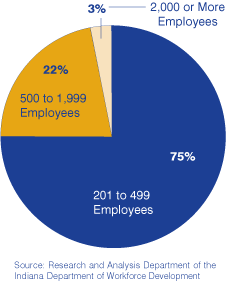
Of these, 1,171 have between 201 and 500 employees, while only 394 establishments
employ more than 500 individuals. The establishments with over 200 employees
employed 823,366 persons in the third quarter of 2004 (33 percent of the
in-scope employment for the quarter) and paid 41 percent of the total
wages. The 47 largest of these establishments, with 2,000 or more employees
each, provided aggregate employment of 163,125 (6.6 percent) and paid
wages of $2.26 billion (10.7 percent), slightly less than the totals for
all establishments employing one to nine persons (see Table 2).
Table 2: Employment and Wage Comparison by Establishment Size
As you can see from Figure 4, these firms with the heaviest concentration of employees are relatively few and far between with some concentration in the middle part of the state.
Figure 4: Establishments with More than 2,000 Employees
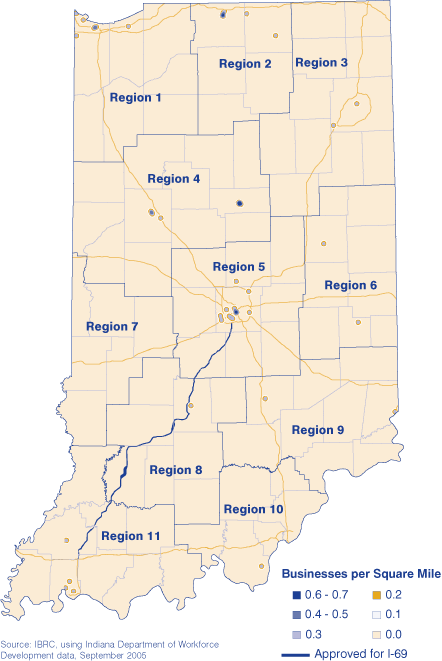
The middle ground between the employers with less than 10 or more than 200 employees are broken into five size classes, each encompassing a roughly equal number of units (see Figure 5).
Figure 5: Employment Size, 10 to 200
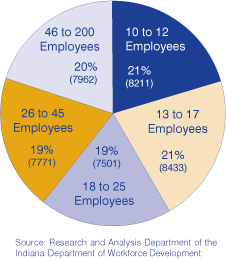
Collectively, these five size classes comprise 54 percent of the state’s employment and 48 percent of wages paid by private sector employers. The nearly 40,000 establishments in these size classes form the backbone of Indiana’s economy in many ways. They comprise 96 percent of the units with 10 or more employees and 31 percent of all non-zero employment units in the private sector. The Department of Workforce Development is working to increase awareness of the agency’s services among employers with 100 employees or less. For example, the Training Acceleration Grant (TAG) is designed to provide financial assistance to companies and organizations committed to expanding the skills of their existing workforce through training programs that result in industry-recognized credentials. For additional information, please visit the agency’s homepage (www.in.gov/dwd) or the Training Acceleration Grant (TAG) page at www.in.gov/dwd/employers/tag.html.
Vicki Seegert, ManagerAdvanced Economic and Market Analysis Group, Indiana Department of Workforce Development

